Ever stained wood and noticed a lighter hue as it dries? Curious if this is normal or a cause for concern? Let’s unravel this mystery together!

Did you know that initiating a woodworking project entails more than just selecting the appropriate stain?
I was intrigued by how stain reacts during the drying process, so I conducted extensive research with the assistance of wood finishing experts in the San Francisco area.
My primary focus was to understand whether the stain dries darker, lighter, or retains its original shade during the drying process.
Thanks to the comprehensive research and interviews conducted, I amassed a wealth of information and have been applying the tips and techniques learned over the years.
So, let’s find out, Does stains lighten as it dries?
Yes, wood stain typically lightens as it dries. During the drying process, water-based stains show a lighter color compared to their wet state, while oil-based stains deepen in color as they dry, resulting in a clearer appearance.
But that’s just a quick snapshot of the question!

I know that these facts about woodworking stains are not enough for you, so if you came today to search for these stains, stay tuned with me.
In this article, I’ll explore does stains lighten as it dries and I’ll teach you the techniques to lighten stains, creating the perfect finish for your woodworking ventures.
Let’s dig in!

Does Stain Dry Darker or Lighter?
As you know, the color change of the stain during the drying process depends on various factors such as the type of stain and the wood it is applied to.
Usually, oil-based stains darken as they dry, enhancing the wood’s natural richness.
On the other hand, water-based stains usually dry lighter and maintain a close resemblance to the color originally chosen.
Not only that, but the porosity of the wood can also affect this, as more porous wood will absorb more stains and appear darker after drying.

Does Stain Change Color as It Dries?
Yes, of course, the stain often undergoes a color change during the drying process.
For example, oil-based stains deepen in color when dry, and you’ll see a more vivid color compared to their wet state.
However, water-based stains experience minimal color shift during drying, true to the color originally applied.
I advise you to consider the specific characteristics of the stain and follow the manufacturer’s guidelines for accurate expectations of color changes during the drying phase.
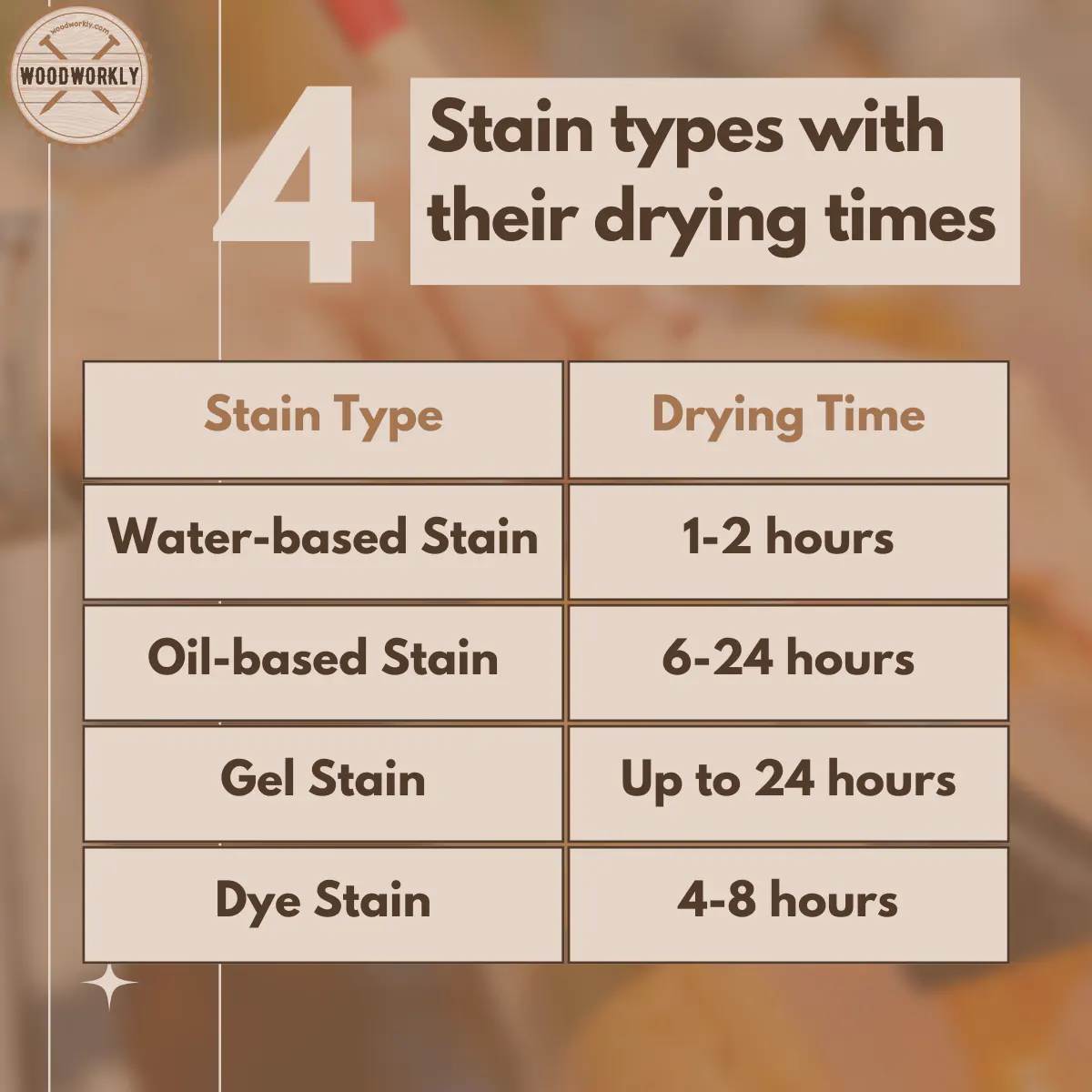
Does Stain Get Darker the Longer It Sits?
No, the duration of the stain on the wood does not cause continuous darkening.
You may find that oil-based stains show some darkening during the drying time, but leaving the stain on the wood longer than the recommended drying time may not change the color significantly.
Remember; It is very important to follow the recommended application and drying times provided by the stain manufacturer to achieve the desired color.
Stains are adjusted to achieve optimal color within specific time frames, and I can confirm that exceeding these will not result in further darkening.

Does Deck Stain Lighten Over Time?
Yes, but it happens due to exposure to environmental factors like sunlight, weather and foot traffic. Also, the sun’s ultraviolet (UV) rays can cause stains to fade and lighten over time.
Additionally, constant use and exposure to the elements can contribute to wear and tear, gradually lightening the look of the deck’s stain.
You can choose a high-quality, UV-resistant stain and apply it according to the manufacturer’s recommendations to help slow the fading process and maintain the deck’s aesthetic appeal for longer.
I must remind you here that regular maintenance, including cleaning and reapplying as needed, is essential to preserving the color of the deck stain over time.
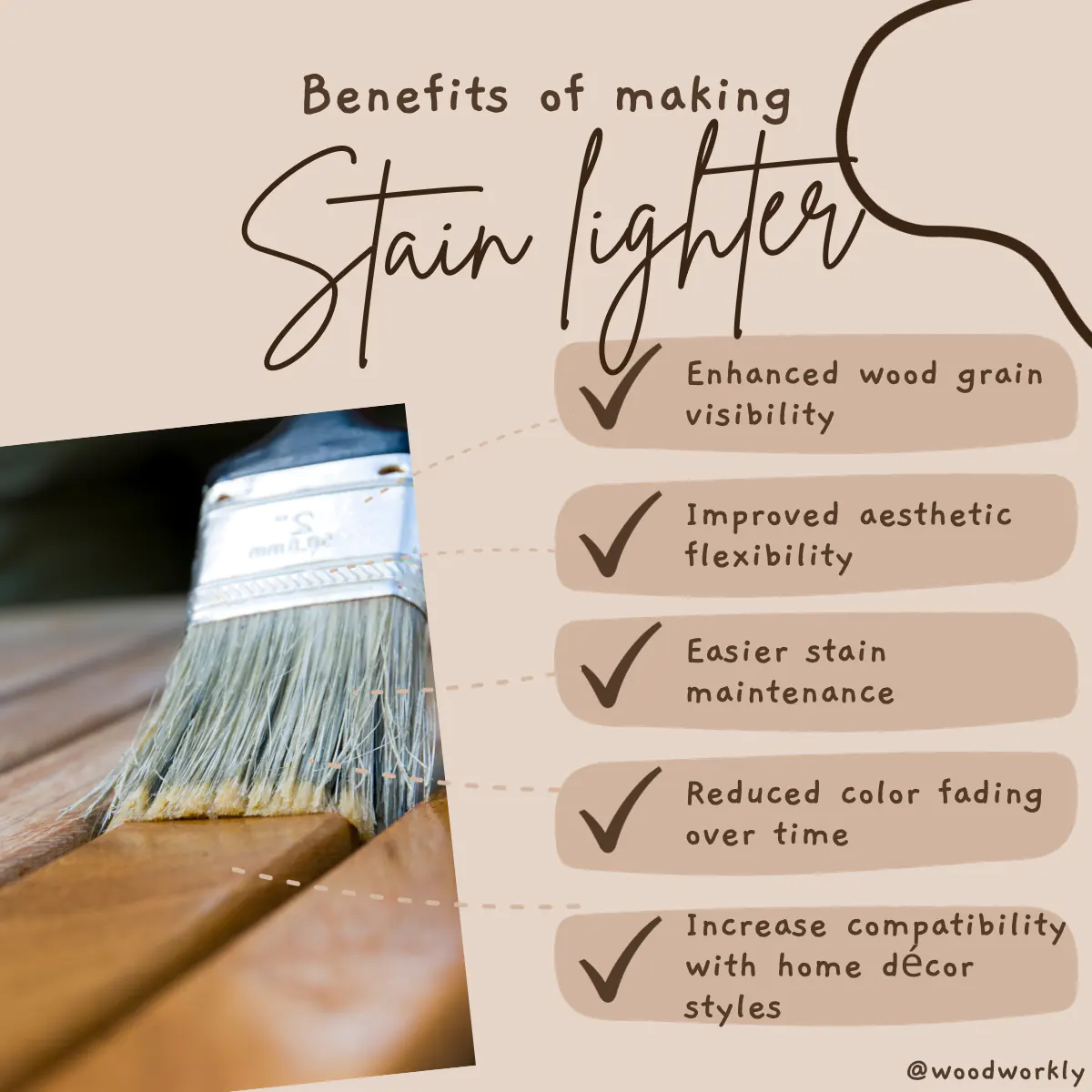
How to Lighten Stains?
When it comes to woodworking, if you’ve applied a darker-than-anticipated wood stain or wish to lighten an existing stained surface, are you aware that there are effective ways to achieve this without removing the stain entirely?
Here, I detail two methods I use specifically to lighten stains; lighten stains with vinegar and lighten stains with bleach.
How to Lighten Stains with Vinegar
You can use the following simple steps to lighten stains with vinegar.
- Gather Your Supplies
- Mix the Solution Well
- Test in a Small Area
- Apply the Solution
- Rinse and Dry
- Sealing or Re-Staining
Now let’s see in detail about these methods that I used.
1. Gather Your Supplies
For this method, you first need white vinegar, a clean cloth or sponge, and a bucket.
2. Mix the Solution Well
I advise you to dilute white vinegar with water in a ratio of 1:1. This creates a mild acid solution that helps lighten the stain without damaging the wood.
3. Test in a Small Area
One thing you should definitely remember is that before applying the vinegar solution to the entire stained surface, test it on a small, inconspicuous area of the wood to ensure that it will not have any adverse effects.
4. Apply the Solution
Here I advise you to soak a clean cloth or sponge in the vinegar-water mixture and gently rub it on the stained area. C
5. Rinse and Dry
After you have achieved the desired level of polishing, rinse the wood surface with clean water to remove any remaining vinegar. Then allow the wood to dry thoroughly.
6. Sealing or Re-Staining
After lightening the stain, depending on the needs of your project, you may need to reapply a wood sealer or stain to protect and enhance the appearance of the wood.
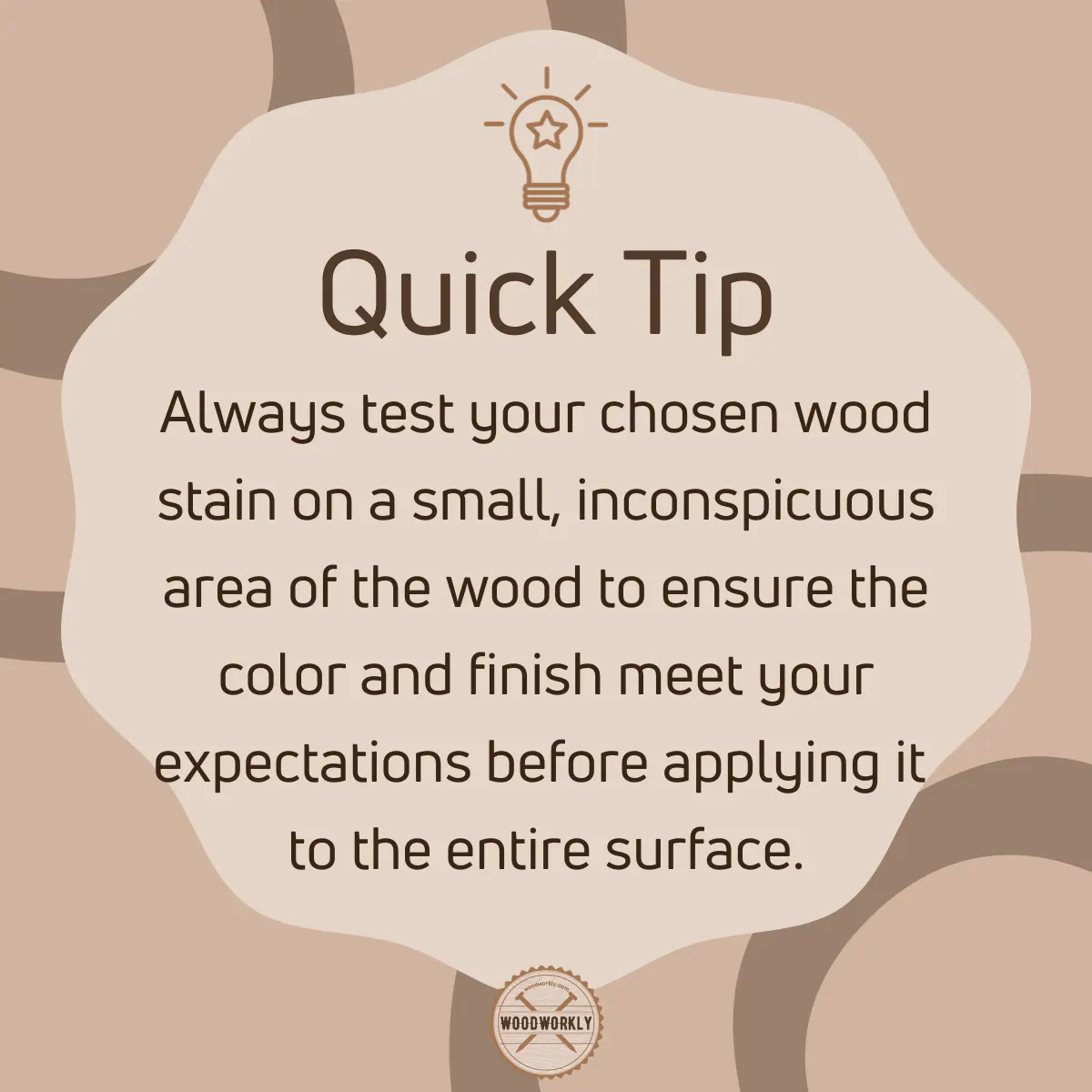
How to Lighten Stains with Bleach
Now I will share with you some simple steps I used to lighten stains with bleach.
- Safety First
- Dilute the Bleach
- Test in a Small Area
- Apply the Solution
- Wash and Neutralize
- Dry and Reseal
Let’s see this step in detail now.
1. Safety First
When working with bleach, you must work in a well-ventilated area, wear protective gear such as gloves and safety glasses, and follow the safety guidelines on the bleach container.
2. Dilute the Bleach
I advise you to mix household bleach with water in a ratio of 1:4 or 1:5. This creates a mild bleach solution suitable for lightening stains.
3. Test in a Small Area
As with vinegar, first test the diluted bleach solution on a small, hidden area of the stained wood to check for any adverse reactions.
4. Apply the Solution
You can use a sponge or cloth to apply the diluted bleach solution evenly to the stained area. Avoid working in small sections and over-saturating the wood.
5. Wash and Neutralize
After you have achieved the desired lightening, wash the wood thoroughly with water to remove any remaining bleach.
To neutralize the bleach, you can follow a solution of water and vinegar (1:1).
6. Dry and Reseal
Allow the wood to dry completely before considering re-staining or sealing to protect the newly lightened surface and restore its finish.
You should definitely remember to use caution when working with bleach and consult the stain manufacturer’s recommendations for the best results.
Apart from the above method, you can mix different types of stains to get the perfect shade you want.
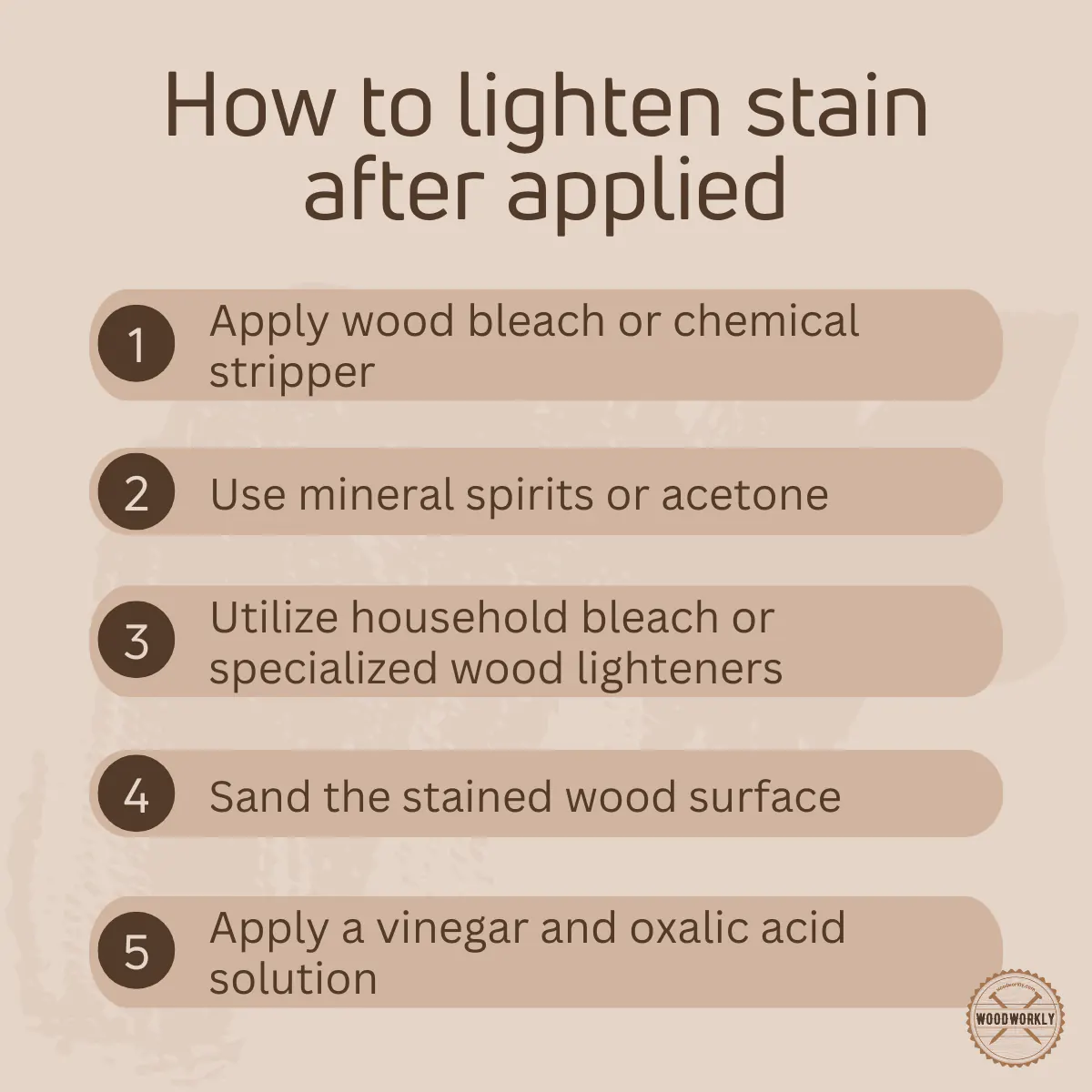
How Long Does Stain Take to Dry?
You should be aware that drying times for stains generally vary depending on factors such as composition and environmental conditions, as well as the type of stain used.
I will now tell you how the drying time of stains varies depending on the type of stain used which I discovered during my research.
1. Water-Based Stains
Generally, water-based stains take a very short time of 4 to 6 hours to dry.
These stains are ideal for projects that require efficiency. Applying thin coats and working in a warm, dry environment with good ventilation can speed up your drying process.
However, if you want a completely finished look, I would advise you to let the stain dry for about 48 hours before applying a sealing finish coat.
2. Oil-Based Stains
Oil-based stains take the most varied drying time between coats, ranging from 2 to 12 hours.
In general, a waiting period of 24 to 48 hours is recommended before finishing on stained surfaces and product directions should be followed if you want to achieve optimal results.
3. Gel-Based Stains
Did you know that gel-based stains take about 24 hours to dry between coats?
The advantage of using gel-based stains is that they are suitable for stained surfaces due to their ability to effectively cover wood imperfections.
However, remember that you will have to wait a long 72 hours before applying a sealant.
Also, unlike water- and oil-based stains, gel stains act as a protective coating and require a longer drying time.
4. Lacquer Stains
Lacquer stains give you the shortest drying time between coats, approximately 15 minutes.
Often favored by professional woodworkers for its durable finish, the lacquer requires 24 hours to dry completely before applying additional finishing touches.
I advise you to be sure to take safety precautions when using lacquer and wear respirators and gloves.
5. Water Soluble Dye Stains
Water-soluble dye stains, available in powder form, take about 24 hours to dry.
Although application involves mixing the paint with water, you must be careful as these stains may fade in direct light.
Therefore, they are less suitable for outdoor projects that require prolonged exposure to sunlight.
Understanding the drying times of various stains is critical for crafters and DIY enthusiasts to effectively plan their projects.

How Many Coats Of Stain?
The number of stains you apply to the wood depends on a variety of factors, including the type of stain, the type of wood, and the desired finish.
I’ve listed a few things below that will help you decide how much stain is right for your project.
Did you know that the number of stains you apply to wood varies depending on the type of wood you are using?
Because different woods absorb stains at different rates, hardwoods like oak may require fewer coats than softwoods like pine.
It is essential to test a small, inconspicuous area to gauge how the wood will react to the stain.
In addition, water-based stains often require more coats than oil-based ones. Water-based stains can be light, so additional coats may be needed to achieve the desired depth of color.
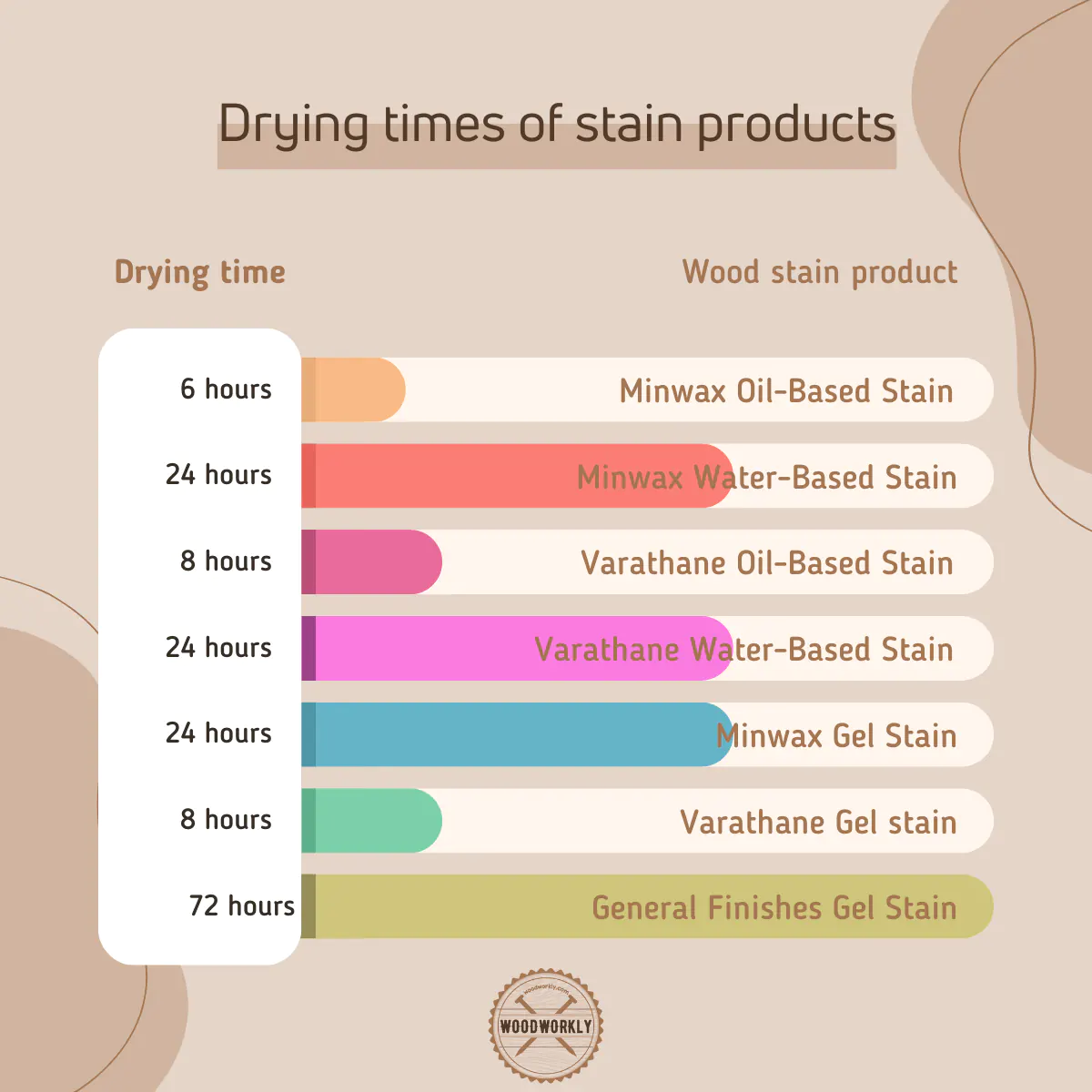
To create a smooth surface, ensure that the wood is properly prepared by sanding. The stain is better suited to a well-prepared surface.
If the wood you are using is new or has never been stained, more coats may be needed to achieve even color penetration.
Keep in mind that the number of coats will vary depending on how intense or subtle you want the final color to be. More coats usually give a richer and deeper color.
Some stains are more translucent, allowing the natural wood grain to show through. Others are more opaque, giving thicker color coverage. You may need additional coats to build up the transparent stain color.
Applying several thin coats allows you a more even and controlled color application, reducing the risk of spotting.
Generally, two or three coats are sufficient for water-based stains. Allow each layer to dry completely before applying the next.
You may need a layer or two for oil-based stains. I suggest you follow the specific instructions on the product label.

Gel stains are thicker and you may need fewer coats, often one to two.
Before multi-coating the entire project, I advise you to apply the stain to a small, inconspicuous area to assess the color and coverage.
Assess color saturation after each coat. If the desired color is obtained, additional coats are not required.
Once the desired color is achieved, consider applying a clear wood sealer or finish to protect the stain and enhance the appearance of the wood.
I advise you to always follow the specific recommendations provided by the manufacturer.
Does Stain Get Darker with More Coats?
Yes, in general, the stain tends to get darker with more coats.
Each additional stain adds more color to the wood, so you can see the color deepen and the finish increase in richness.
However, you should keep in mind that this depends on a variety of factors, including the degree to which the stain darkens, the type of stain, the porosity of the wood, and the transparency of the stain.
Additionally, water-based stains may require more coats to achieve deeper color, while oil-based stains often provide more intense color with fewer coats.
It is advisable to test the stain on a small, inconspicuous area before applying multiple coats to the entire surface to achieve the desired darkness without overdoing it.
Additionally, you can achieve a more even and controlled color progression by allowing each coat to dry completely before applying the next.

Does Water Make the Stain Look Lighter?
Yes, water can lighten the stain on wood.
When a water-based stain is applied to wood, the water content of the stain can temporarily raise the grain of the wood and make the color appear lighter.
Did you know that this effect is known as “grain raising“?
In addition, water can dilute the concentration of the stain, affecting its color intensity.
However, it is important to note that this lightening effect is usually temporary. As the wood dries and the stain cures, the color often darkens to its true and desired shade.
If you want to get a more accurate preview of the final color, I advise you to allow the wood to dry completely and follow the manufacturer’s recommended drying times and application procedures before judging the appearance of the stain.
Congrats folks! Now you know all you need to know about does stain lighten as it dries or it won’t in detail.
Basically, the answer is Yes, the stain lightens as it dry!

So, let’s answer some frequently asked questions as well.
FAQs
Can vinegar be used to lighten wood stain?
Yes, vinegar can lighten unintentional dark stains on wood without causing damage. However, its effectiveness is best noted on mild, water-based wood stains.
Does household bleach effectively lighten wood stains?
Household bleach can remove pigments in wood stains or dyes but does not always effectively lighten the wood’s color. For better results, specialized wood bleaches or stronger chemicals like oxalic acid are recommended.
Does oil-based stain lighten as it dries?
Oil-based stains do lighten as they dry but return to their darker, wet shade after the finish is applied, similar to water-based stains.
Will the stain get darker with polyurethane?
Oil-based polyurethane can darken wood stains due to its oxidizing nature, while water-based polyurethane generally has no effect on the stain’s color.
What do I do if my wood stain is too dark?
To lighten a too-dark wood stain, you can use wood bleach, mineral spirits, or vinegar, applying them with a paintbrush or rag and then cleaning the surface with a damp cloth.
How long does wood stain take to dry?
The drying time of wood stain depends on its type, with water-based stains drying faster and oil-based and gel stains requiring more time. Environmental conditions like temperature and humidity also affect the drying time.
Can I add water to lighten water-based wood stain?
Yes, water can be used to thin water-based stains, but this process might require applying more coats to achieve the desired shade.
How many coats of stain should be applied to the wood?
Typically, 2 to 4 coats are needed to properly stain wood, with each additional coat making the stain darker as it penetrates the wood further.
Do you need to sand wood after staining it?
Yes, sanding after staining helps to even out the surface, remove flaws, and ensure the wood absorbs subsequent coats of stain or finish effectively.
Did I Cover all you wanted to know about: Does Stain Lighten As It Dries
In this article, I’ve deeply discussed does stain lighten as it dries, how to make stain lighter using different methods and number of stain coats you need to apply under different conditions.
Drying the stain can actually cause you to lighten the color. However, it regains its original, darker color once the finishing coat is applied. The lightening is temporary and part of the drying process.
Furthermore, I’ve answered some frequently asked questions as well.
Hope you’ve larned everything you wanted to know about does stain lighten as it dries including experts’ tips and techniques.
Now it’s time for you to try this out and check whether you’ll get light stain shade on your beautiful furniture. Keep practicing to become a pro! Happy wood finishing!